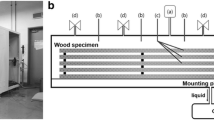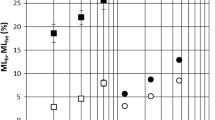Abstract
We examined wood liquefaction using phenol and mixed acid catalysts with microwave heating, and compared that with similar processes that use oil bath heating. The reaction time for microwave heating to achieve a residue content was one sixth, one eighteenth, and one twenty-fourth of that from oil bath heating, respectively, for phenol to wood (P/W) ratios of 2.5/1, 2/1 and 1.5/1. A low P/W ratio tended to result in carbonization of liquefied wood due to an insufficient amount of phenol and localized microwave superheating. Fourier transform infrared spectroscopic (FTIR) evaluation of the liquefied residue, showed that the liquefaction rates of wood components differed. Hemicellulose was most susceptible to liquefaction, crystalline cellulose was most recalcitrant, and guaiacyl units the most prone to re-condensation. From FTIR, the chemical components and substitution patterns of bonded phenol were similar for both methods.



Similar content being viewed by others
References
Alma MH, Yoshioka M, Yao YG, Shiraishi N (1995) Preparation of oxalic acid- catalyzed resinified phenolated wood and its characterization. J Jpn Wood Res Soc 41:1122–1131
Colom X, Carrillo F (2002) Crystallinity changes in lyocell and viscose-type fibres by caustic treatment. Eur Polym J 38:2225–2230
Faix O (1991) Classification of lignin from different botanical origins by FT-IR spectroscopy. Holzforschung 45(Suppl):21–27
Gabhane J, Prince William SPM, Vaidya AN, Mahapatra K, Chakrabarti T (2011) Influence of heating source on the efficacy of lignocellulosic pretreatment-a cellulosic ethanol perspective. Biomass Bioenergy 35:96–102
Gong GF, Liu DY, Huang YD (2010) Microwave-assisted organic acid pretreatment for enzymatic hydrolysis of rice straw. Biosyst Eng 107:67–73
Hassan EB, Kim M, Wan H (2009) Phenol-formaldehyde-type resins made from phenol-liquefied wood for the bonding of particleboard. J Appl Polymer Sci 112:1436–1443
Hse CY, Feng F, Pan H (2009) Bond quality of phenol-based adhesives containing liquefied creosote-treated wood. In: Hse CY, Jiang ZH, Kuo ML (eds) Advanced biomass science and technology for bio-based products: proceedings. Chinese Academy of Forestry, Beijing, pp 87–95
Huang YB, Zheng ZF, Feng H, Pan H (2011) Phenolic foam from liquefied products of walnut shell in phenol. Adv Mater Res 236–238:241–246
Keshwani DR, Cheng JJ (2009) Switchgrass for bioethanol and other value-added applications: a review. Bioresour Technol 100:1515–1523
Kržan A, Žagar E (2009) Microwave driven wood liquefaction with glycols. Bioresour Technol 100:3143–3146
Lee SH, Ohkita T (2003) Rapid wood liquefaction by supercritical phenol. Wood Sci Technol 37:29–38
Lei HW, Ren SJ, Julson J (2009) The effects of reaction temperature and time and particle size of corn stover on microwave pyrolysis. Energy Fuels 23:3254–3261
Li GY, Hse CY, Qin TF (2012) Preparation and characterization of novolak phenol formaldehyde resin from liquefied brown-rotted wood. J Appl Polymer Sci 125:3142–3147
Lin LZ, Yoshioka M, Yao YG, Shiraishi N (1994) Liquefaction of wood in the presence of phenol using phosphoric acid as a catalyst and the flow properties of the liquefied wood. J Appl Polymer Sci 52:1629–1636
Lin LZ, Nakagame S, Yao YG, Yoshioka M, Shiraishi N (2001) Liquefaction mechanism of β–O–4 lignin model compound in the presence of phenol under acid catalysts part 2. React Behav Pathways. Holzforschung 55:625–630
Oh SY, Yoo D, Shin Y, Kim HC, Kim HY, Chung YS, Park WH, Youke JH (2005) Crystalline structure analysis of cellulose treated with sodium hydroxide and carbon dioxide by means of X-ray diffraction and FTIR spectroscopy. Carbohydr Res 340:2376–2391
Pan H, Shupe T, Hse CY (2009) Characterization of novolac type liquefied wood/phenol/formaldehyde (LWPF) resin. Eur J Wood Prod 67:427–437
Schwanninger M, Rodrigues JC, Pereira H, Hinterstoisser B (2004) Effects of short-time vibratory ball milling on the shape of FT-IR spectra of wood and cellulose. Vib Spectrosc 36:23–40
Wang XH, Chen HP, Luo K, Shao JA, Yang HP (2008) The influence of microwave drying on biomass pyrolysis. Energy Fuels 22:67–74
Yamada T, Ono H (1999) Rapid liquefaction of lignocellulosic waste by using ethylene carbonate. Bioresour Technol 70:61–67
Yao YG (2003) Potential utilization of bio-based waste. In: Kyoto Shinbun, No. 43609
Zhang YC, Ikeda A, Hori N, Takemura A, Ono H, Yamada T (2006) Characterization of liquefied product from cellulose with phenol in the presence of sulfuric acid. Bioresour Technol 97:313–321
Zhao XQ, Song ZL, Liu HZ, Li ZQ, Li LZ, Ma CY (2010) Microwave pyrolysis of corn stalk bale: a promising method for direct utilization of large-sized biomass and syngas production. J Anal Appl Pyrolysis 89:87–94
Acknowledgments
The authors gratefully acknowledge the Southern Research Station, USDA Forest Service, USA for kindly providing the experimental facilities for this study. The financial support of “948 Project” of State Forestry Administration (2012-4-28) is gratefully acknowledged.
Author information
Authors and Affiliations
Corresponding author
Additional information
Project fund: This work was financially supported by the “948 Project” of State Forestry Administration (2012-4-28).
The online version is available at http://www.springerlink.com
Corresponding editor: Yu Lei
Rights and permissions
About this article
Cite this article
Li, G., Hse, C. & Qin, T. Wood liquefaction with phenol by microwave heating and FTIR evaluation. J. For. Res. 26, 1043–1048 (2015). https://doi.org/10.1007/s11676-015-0114-0
Received:
Accepted:
Published:
Issue Date:
DOI: https://doi.org/10.1007/s11676-015-0114-0




